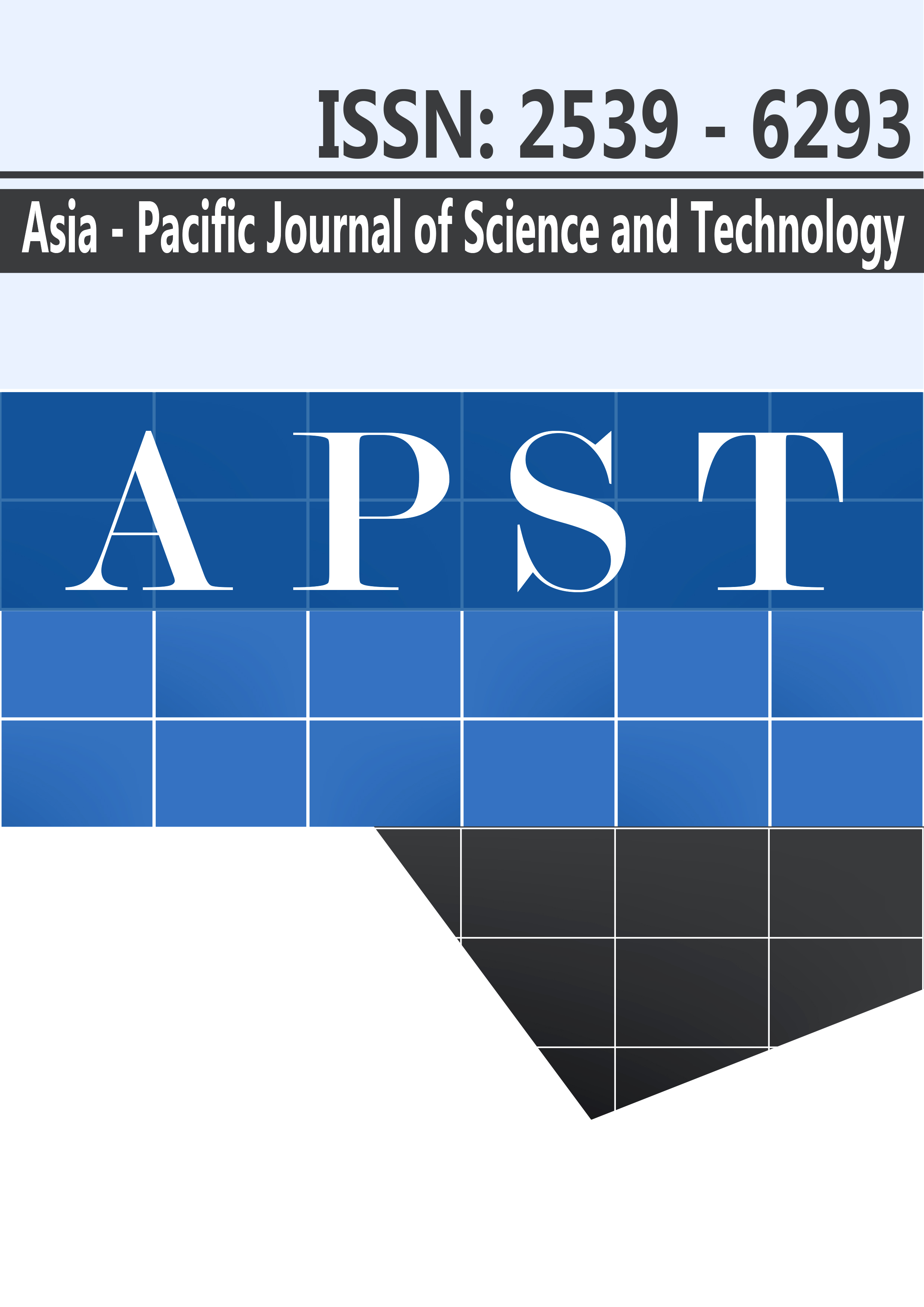Oligosaccharides from rice straw and rice husks produced by glycoside hydrolase family 10 and 11 xylanases
Main Article Content
Abstract
Rice straw (RS) and rice husks (RH) are the by-products obtained from rice farming, which are the remaining non-starch polysaccharides, called cellulose and hemicellulose. The objectives of this study were to investigate the abilities of the glycoside hydrolase family 10 (GH10) and 11 (GH11) commercial xylanases on the production of oligosaccharides from RS and RH by hydrothermal assisted enzymatic hydrolysis. Firstly, RS and RH were pretreated with acetone/ethanol. Then the pretreated biomass was heated by autoclave at 180 ˚C for 10-30 min. The oligosaccharides content in the RS and RH hydrolysates (HRS and HRH) were analyzed by High Performance Anion Exchange Chromatography (HPAEC-PAD). The results indicated that RS and RH treated for 10 min had shown the highest total oligosaccharides content. After that, the HRS and HRH were hydrolyzed with Ultraflo Max (UM10) and Ultraflo L (UL11), belonged to GH10 and GH11 respectively, under condition at 50 ˚C pH of 6.0 for 0-4 h. The highest sugar-reducing content was found while incubating HRS and HRH for 1 h with the aforementioned xylanases. The sugar-reducing contents of HRS and HRH treated with UM10 increased up to 0.24% and 0.17%, respectively, whereas those treated with UL11 increased up to 0.18% and 0.14%, respectively. The results revealed that HRS and HRH treated with UM10 had mainly consisted of xylobiose, while those treated with UL11 had mainly consisted of xylotriose. This study has suggested the potential of GH10 and GH11 xylanases on Xylooligosaccharide (XOS) production using RS and RH as alternative sources.
Article Details
References
Isvilanonda S. Thai rice in the world rice market and driving Thai rice economy with research. [Internet]. 2018 [cited 2019 Feb 29]. Available from: https://www.arda.or.th/datas/riceconref1.pdf.
Worasuwannarak N, Sonobe T, Tanthapanichakoon W. Pyrolysis behaviors of rice straw, rice husk, and corncob by TG-MS technique. J Anal Appl Pyrol. 2007;78(2):265-271.
Kulkarni N, Shendye A, Rao M. Molecular and biotechnological aspects of xylanases. FEMS Microbiol Rev. 1999;23(4):411-456.
Gírio FM, Fonseca C, Carvalheiro F, Duarte LC, Marques S, Bogel-Łukasik R. Hemicelluloses for fuel ethanol: a review. Bioresource Technol. 2010;101(13):4775-4800.
Heitz M, Carrasco F, Rubio M, Chauvette G, Chornet E, Jaulin, L, Overend RP. Generalized correlations for the aqueous liquefaction of lignocellulosics. Can J Chem Eng. 1996;64(4):647-650.
Verma D, Satyanarayana T. Molecular approaches for ameliorating microbial xylanases. Bioresource Technol. 2012;117:360-367.
Collins T, Gerday C, Feller G. Xylanases, xylanase families and extremophilic xylanases. FEMS Microbiol Rev. 2005;29(1):3-23.
Coutinho PM, Stam M, Blanc E, Henrissat B. Why are there so many carbohydrate-active enzyme-related genes in plants. Trends Plant Sci. 2003;8(12):563-565.
Paës G, Berrin JG, Beaugrand J. (2012). GH11 xylanases: structure/ function/ properties relationships and applications. Biotechnol Adv. 2012;30(3):564-592.
Biely P, Vršanská M, Tenkanen M, Kluepfel D. Endo-β-1,4-xylanase families: differences in catalytic properties. J Biotechnol. 1997;57(1-3):151-166.
Dodd D, Cann IK. (2009). Enzymatic deconstruction of xylan for biofuel production. Gcb Bioenergy. 2009;1(1):2-17.
Huijgen J, Reith J, Uil H. Pretreatment and fractionation of wheat straw by an acetone-based organosolv process. Ind Eng Chem Res. 2010;49(20):10132-10140.
Sluiter A, Hames B, Ruiz R, Scarlata, C, Sluiter J, Templeton D. Determination of sugars, byproducts, and degradation products in liquid fraction process samples. Golden (CO): National Renewable Energy Laboratory; 2006.
Jaichakan P, Dang Thi HN, Nakphaichit M, Klangphetch W. The Effect of alkali pretreatment and acid debranching on rice husk, rice straw and defatted rice bran for xylobiose production by commercial xylanases. Bankok: Srinakharinwirot University; 2019.
Miller GL. Use of dinitrosalicylic acid reagent for determination of reducing sugar. Anal Chem. 1959;31(3):426-428.
Peterson AA, Vogel F, Lachance RP, Fröling M, Antal Jr. MJ, Tester JW. Thermochemical biofuel production in hydrothermal media: a review of sub-and supercritical water technologies. Energy Environ Sci. 2008;1:32-65.
McCleary BV, McKie VA, Draga A, Rooney E, Mangan D, Larkin J. Hydrolysis of wheat flour arabinoxylan, acid-debranched wheat flour arabinoxylan and arabino-xylo-oligosaccharides by β-xylanase, α-l-arabinofuranosidase and β-xylosidase. Carbohyd Res. 2015;407:79-96.
Gagić T, Perva-Uzunalić A, Knez Z, Škerget M. Hydrothermal Degradation of Cellulose at Temperature from 200 to 300° C. Ind Eng Chem Res. 2018;57(18):6576-6584.
Mathew S, Karlsson EN, Adlercreutz P. Extraction of soluble arabinoxylan from enzymatically pretreated wheat bran and production of short xylo-oligosaccharides and arabinoxylo-oligosaccharides from arabinoxylan by glycoside hydrolase family 10 and 11 endoxylanases. J Biotechnol. 2017; 53-61.
Mäkeläinen H, Saarinen M, Stowell J, Rautonen N, Ouwehand A. Xylo-oligosaccharides and lactitol promote the growth of Bifidobacterium lactis and Lactobacillus species in pure cultures. Benef Microbes. 2010;1(2):139-148.
Chapla D, Pandit P, Shah A. Production of xylooligosaccharides from corncob xylan by fungal xylanase and their utilization by probiotics. Bioresource Technol. 2012;115:215-221.
Juturu V, Wu JC. (2014). Microbial exo-xylanases: a mini review. Appl Biochem Biotechnol 2014;174:81-92.


